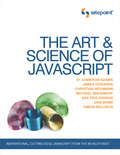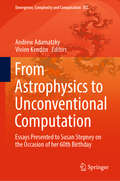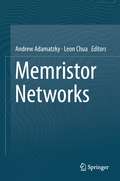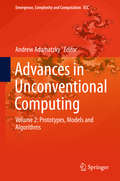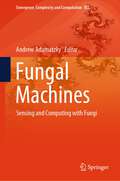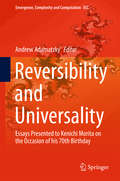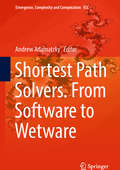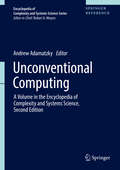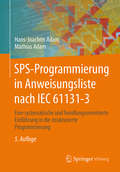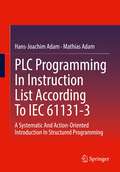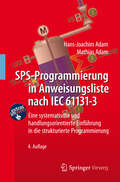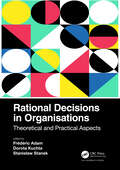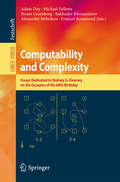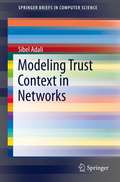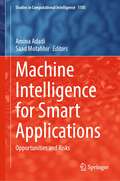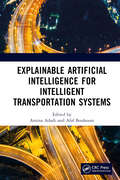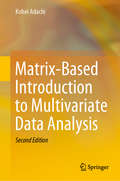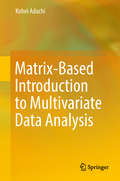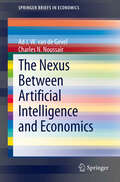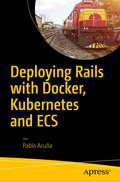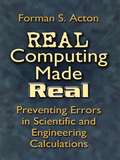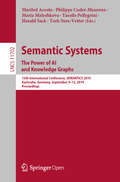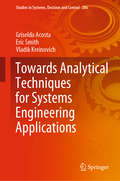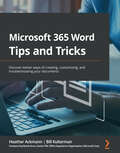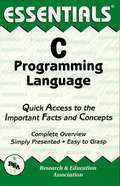- Table View
- List View
The Art & Science of JavaScript: Inspirational, Cutting-Edge JavaScript From the World's Best
by Cameron Adams James Edwards Christian Heilmann Michael Mahemoff Ara Pehlivanian Dan Webb Simon WillisonWe've assembled seven of the greatest minds in modern JavaScript to teach you the most inspirational techniques you'll ever use. From creating impressive mashups and stunning, dynamic graphics, to more subtle user-experience enhancements, you're about to be amazed by the true potential of this powerful language.With an all star line-up of authors including James Edwards, Michael Mahemoff, Ara Pehlivanian, Cameron Adams, Dan Webb, Christian Heilmann, and Simon Willison, this superb book will show you how to:Create a slick Google Maps and Flickr mashup.Build your own fully accessible 3D maze.Create stunning vector graphics using the canvas element.Have some fun with draggable and sortable table columns.Give your site some extra personality with client-side badges.Write better code faster using metaprogramming techniques.Become a debugging expert using pro-level Firebug tricks.Presented in full color, all of the books solutions are cross-browser and cross-platform compatible. Best of all, all the code used in the book is available for you to download and experiment with.Who Should Read This Book?This book is targeted at intermediate JavaScript developers who want to take their JavaScript skills to the next level without sacrificing web accessibility or best practice.If you have even a small amount of experience with JavaScript, and are comfortable enough programming in another language such as PHP or Java, you'll be just fine - we'll hold your hand along the way, and all of the code is available for you to download and experiment with on your own.
From Astrophysics to Unconventional Computation: Essays Presented to Susan Stepney on the Occasion of her 60th Birthday (Emergence, Complexity and Computation #35)
by Andrew Adamatzky Vivien KendonThis Festschrift is a tribute to Susan Stepney’s ideas and achievements in the areas of computer science, formal specifications and proofs, complex systems, unconventional computing, artificial chemistry, and artificial life. All chapters were written by internationally recognised leaders in computer science, physics, mathematics, and engineering. The book shares fascinating ideas, algorithms and implementations related to the formal specification of programming languages and applications, behavioural inheritance, modelling and analysis of complex systems, parallel computing and non-universality, growing cities, artificial life, evolving artificial neural networks, and unconventional computing. Accordingly, it offers an insightful and enjoyable work for readers from all walks of life, from undergraduate students to university professors, from mathematicians, computers scientists and engineers to physicists, chemists and biologists.
Memristor Networks
by Andrew Adamatzky Leon ChuaUsing memristors one can achieve circuit functionalities that are not possible to establish with resistors, capacitors and inductors, therefore the memristor is of great pragmatic usefulness. Potential unique applications of memristors are in spintronic devices, ultra-dense information storage, neuromorphic circuits and programmable electronics. Memristor Networks focuses on the design, fabrication, modelling of and implementation of computation in spatially extended discrete media with many memristors. Top experts in computer science, mathematics, electronics, physics and computer engineering present foundations of the memristor theory and applications, demonstrate how to design neuromorphic network architectures based on memristor assembles, analyse varieties of the dynamic behaviour of memristive networks and show how to realise computing devices from memristors. All aspects of memristor networks are presented in detail, in a fully accessible style. An indispensable source of information and an inspiring reference text, Memristor Networks is an invaluable resource for future generations of computer scientists, mathematicians, physicists and engineers.
Advances in Unconventional Computing: Volume 2: Prototypes, Models and Algorithms (Emergence, Complexity and Computation #23)
by Andrew AdamatzkyThe unconventional computing is a niche for interdisciplinary science, cross-bred of computer science, physics, mathematics, chemistry, electronic engineering, biology, material science and nanotechnology. The aims of this book are to uncover and exploit principles and mechanisms of information processing in and functional properties of physical, chemical and living systems to develop efficient algorithms, design optimal architectures and manufacture working prototypes of future and emergent computing devices. This first volume presents theoretical foundations of the future and emergent computing paradigms and architectures. The topics covered are computability, (non-)universality and complexity of computation; physics of computation, analog and quantum computing; reversible and asynchronous devices; cellular automata and other mathematical machines; P-systems and cellular computing; infinity and spatial computation; chemical and reservoir computing. The book is the encyclopedia, the first ever complete authoritative account, of the theoretical and experimental findings in the unconventional computing written by the world leaders in the field. All chapters are self-contains, no specialist background is required to appreciate ideas, findings, constructs and designs presented. This treatise in unconventional computing appeals to readers from all walks of life, from high-school pupils to university professors, from mathematicians, computers scientists and engineers to chemists and biologists.
Fungal Machines: Sensing and Computing with Fungi (Emergence, Complexity and Computation #47)
by Andrew AdamatzkyThis unique book explores fungi as sensors, electronic devices, and potential future computers, offering eco-friendly alternatives to traditional electronics. Fungi are ancient, widely distributed organisms ranging from microscopic single cells to massive mycelium spanning hectares. They possess senses similar to humans, detecting light, chemicals, gases, gravity, and electric fields. It covers fungal electrical activity, sensors, electronics, computing prototypes, and fungal language. Authored by leading experts from diverse fields, the book is accessible to readers of all backgrounds, from high-schoolers to professors. It reveals the remarkable potential of fungal machines while minimizing environmental impact.
Reversibility and Universality: Essays Presented To Kenichi Morita On The Occasion Of His 70th Birthday (Emergence, Complexity And Computation Ser. #30)
by Andrew AdamatzkyThis book is a tribute to Kenichi Morita’s ideas and achievements in theoretical computer science, reversibility and computationally universal mathematical machines. It offers a unique source of information on universality and reversibility in computation and is an indispensable book for computer scientists, mathematicians, physicists and engineers. Morita is renowned for his works on two-dimensional language accepting automata, complexity of Turing machines, universality of cellular automata, regular and context-free array grammars, and undecidability. His high-impact works include findings on parallel generation and parsing of array languages by means of reversible automata, construction of a reversible automaton from Fredkin gates, solving a firing squad synchronization problem in reversible cellular automata, self-reproduction in reversible cellular spaces, universal reversible two-counter machines, solution of nondeterministic polynomial (NP) problems in hyperbolic cellular automata, reversible P-systems, a new universal reversible logic element with memory, and reversibility in asynchronous cellular automata.Kenichi Morita’s achievements in reversibility, universality and theory of computation are celebrated in over twenty high-profile contributions from his colleagues, collaborators, students and friends. The theoretical constructs presented in this book are amazing in their diversity and depth of intellectual insight, addressing: queue automata, hyperbolic cellular automata, Abelian invertible automata, number-conserving cellular automata, Brownian circuits, chemical automata, logical gates implemented via glider collisions, computation in swarm networks, picture arrays, universal reversible counter machines, input-position-restricted models of language acceptors, descriptional complexity and persistence of cellular automata, partitioned cellular automata, firing squad synchronization algorithms, reversible asynchronous automata, reversible simulations of ranking trees, Shor’s factorization algorithms, and power consumption of cellular automata.
Shortest Path Solvers. From Software to Wetware (Emergence, Complexity And Computation Ser. #32)
by Andrew AdamatzkyThis book offers advanced parallel and distributed algorithms and experimental laboratory prototypes of unconventional shortest path solvers. In addition, it presents novel and unique algorithms of solving shortest problems in massively parallel cellular automaton machines. The shortest path problem is a fundamental and classical problem in graph theory and computer science and is frequently applied in the contexts of transport and logistics, telecommunication networks, virtual reality and gaming, geometry, and social networks analysis. Software implementations include distance-vector algorithms for distributed path computation in dynamics networks, parallel solutions of the constrained shortest path problem, and application of the shortest path solutions in gathering robotic swarms. Massively parallel algorithms utilise cellular automata, where a shortest path is computed either via matrix multiplication in automaton arrays, or via the representation of data graphs in automaton lattices and using the propagation of wave-like patterns. Unconventional shortest path solvers are presented in computer models of foraging behaviour and protoplasmic network optimisation by the slime mould Physarum polycephalum and fluidic devices, while experimental laboratory prototypes of path solvers using chemical media, flows and droplets, and electrical current are also highlighted. The book will be a pleasure to explore for readers from all walks of life, from undergraduate students to university professors, from mathematicians, computers scientists and engineers to chemists and biologists.
Unconventional Computing: A Volume in the Encyclopedia of Complexity and Systems Science, Second Edition (Encyclopedia of Complexity and Systems Science Series #22)
by Andrew AdamatzkyThis volume of the Encyclopedia of Complexity and Systems Science, Second Edition, is a unique collection of concise overviews of state-of-art, theoretical and experimental findings, prepared by the world leaders in unconventional computing. Topics covered include bacterial computing, artificial chemistry, amorphous computing, computing with Solitons, evolution in materio, immune computing, mechanical computing, molecular automata, membrane computing, bio-inspired metaheuristics, reversible computing, sound and music computing, enzyme-based computing, structural machines, reservoir computing, infinity computing, biomolecular data structures, slime mold computing, nanocomputers, analog computers, DNA computing, novel hardware, thermodynamics of computation, and quantum and optical computing. Topics added to the second edition include: social algorithms, unconventional computational problems, enzyme-based computing, inductive Turing machines, reservoir computing, Grossone Infinity computing, slime mould computing, biomolecular data structures, parallelization of bio-inspired unconventional computing, and photonic computing.Unconventional computing is a cross-breed of computer science, physics, mathematics, chemistry, electronic engineering, biology, materials science and nanotechnology. The aims are to uncover and exploit principles and mechanisms of information processing in, and functional properties of, physical, chemical and living systems, with the goal to develop efficient algorithms, design optimal architectures and manufacture working prototypes of future and emergent computing devices.
SPS-Programmierung in Anweisungsliste nach IEC 61131-3
by Mathias Adam Hans-Joachim AdamDas Lehr- und Übungsbuch vermittelt solides Grundwissen und umfassende praktische Fähigkeiten bei der SPS-Programmierung. Im Anschluss an vier Kapitel, die die verschiedenen Zahlensysteme sowie die Digitaltechnik behandeln, folgen Programmierbeispiele: Schaltnetze, Signalspeicher, Zeitfunktionen, Zähler, Funktionsbausteine und Funktionen, Programmstrukturen, Ablaufsteuerungen u. a. Mit der im Internet bereitgestellten Simulationssoftware und den Musterlösungen können Leser das erworbene Wissen direkt anwenden.
PLC Programming In Instruction List According To IEC 61131-3: A Systematic And Action-Oriented Introduction In Structured Programming
by Hans-Joachim Adam Mathias AdamThis textbook and exercise book provides a solid basic knowledge and comprehensive practical skills in dealing with PLC programming. Numerous exercises help to deepen the material. With the accompanying simulation software and sample solutions, the acquired knowledge can be applied immediately. The software can be downloaded via the Internet. The knowledge of number systems and digital technology conveyed in the book is an important prerequisite for skilful and clever PLC programming. The programming language used, "Instruction list according to IEC 61131-3", provides the best insights into the functioning of a PLC. The didactically prepared programming examples for switching networks, signal memories, time functions, counters, function blocks and functions, program structures, sequence controls, data types and much more enable systematic learning of programming. The 5th, corrected edition experiences an expansion of the exercises with a didactically prepared project for the control of a mountain railway. The associated simulation software "PLC-lite" enables the realisation of controls for the mountain railway and the "realistic" representation of the cableway movements on the screen.
SPS-Programmierung in Anweisungsliste nach IEC 61131-3: Eine systematische und handlungsorientierte Einführung in die strukturierte Programmierung
by Hans-Joachim Adam Mathias AdamDas Lehr- und Übungsbuch vermittelt solides Grundwissen und umfassende praktische Fähigkeiten bei der SPS-Programmierung. Im Anschluss an vier Kapitel, die die verschiedenen Zahlensysteme sowie die Digitaltechnik behandeln, folgen Programmierbeispiele: Schaltnetze, Signalspeicher, Zeitfunktionen, Zähler, Funktionsbausteine und Funktionen, Programmstrukturen, Ablaufsteuerungen u. a. Mit der im Internet bereitgestellten Simulationssoftware und den Musterlösungen können Leser das erworbene Wissen direkt anwenden.
Rational Decisions in Organisations: Theoretical and Practical Aspects
by Frédéric AdamManagers in organisations must make rational decisions. Rational decision making is the opposite of intuitive decision making. It is a strict procedure utilising objective knowledge and logic. It involves identifying the problem to solve, gathering facts, identifying options and outcomes, analysing them, considering all the relationships and selecting the decision. Rational decision making requires support: methods and software tools. The identification of the problem to solve needs methods that would measure and evaluate the current situation. Identification and evaluation of options and analysis of the available possibilities involves analysis and optimisation methods. Incorporating intuition into rational decision making needs adequate methods that would translate ideas or observed behaviours into hard data. Communication, observation and opinions recording is hardly possible today without adequate software. Information and data that form the input, intermediate variables and the output must be stored, managed and made accessible in a user-friendly manner. Rational Decisions in Organisations: Theoretical and Practical Aspects presents selected recent developments in the support of the widely understood rational decision making in organisations, illustrated through case studies. The book shows not only the variety of perspectives involved in decision making, but also the variety of domains where rational decision support systems are needed. The case studies present decision making by medical doctors, students and managers of various universities, IT project teams, construction companies, banks and small and large manufacturing companies. Covering the richness of relationships in which the decisions should and must be taken, the book illustrates how modern organisations operate in chains and networks; they have multiple responsibilities, including social, legal, business and ethical duties. Nowadays, managers in organisations can make transparent decisions and consider a multitude of stakeholders and their diverse features, incorporating diverse criteria, using multiple types and drivers of information and decision-making patterns, and referring to numerous lessons learned. As the book makes clear, the marriage of theoretical ideas with the possibilities offered by technology can make the decisions in organisations more rational and, at the same time, more human.
Computability and Complexity: Essays Dedicated to Rodney G. Downey on the Occasion of His 60th Birthday (Lecture Notes in Computer Science #10010)
by Adam Day, Michael Fellows, Noam Greenberg, Bakhadyr Khoussainov, Alexander Melnikov and Frances RosamondThis Festschrift is published in honor of Rodney G. Downey, eminent logician and computer scientist, surfer and Scottish country dancer, on the occasion of his 60th birthday.The Festschrift contains papers and laudations that showcase the broad and important scientific, leadership and mentoring contributions made by Rod during his distinguished career. The volume contains 42 papers presenting original unpublished research, or expository and survey results in Turing degrees, computably enumerable sets, computable algebra, computable model theory, algorithmic randomness, reverse mathematics, and parameterized complexity, all areas in which Rod Downey has had significant interests and influence. The volume contains several surveys that make the various areas accessible to non-specialists while also including some proofs that illustrate the flavor of the fields.
Modeling Trust Context in Networks
by Sibel AdaliWe make complex decisions every day, requiring trust in many different entities for different reasons. These decisions are not made by combining many isolated trust evaluations. Many interlocking factors play a role, each dynamically impacting the others. In this brief, "trust context" is defined as the system level description of how the trust evaluation process unfolds. Networks today are part of almost all human activity, supporting and shaping it. Applications increasingly incorporate new interdependencies and new trust contexts. Social networks connect people and organizations throughout the globe in cooperative and competitive activities. Information is created and consumed at a global scale. Systems, devices, and sensors create and process data, manage physical systems, and participate in interactions with other entities, people and systems alike. To study trust in such applications, we need a multi-disciplinary approach. This book reviews the components of the trust context through a broad review of recent literature in many different fields of study. Common threads relevant to the trust context across many application domains are also illustrated.
Machine Intelligence for Smart Applications: Opportunities and Risks (Studies in Computational Intelligence #1105)
by Amina Adadi Saad MotahhirThis book provides insights into recent advances in Machine Intelligence (MI) and related technologies, identifies risks and challenges that are, or could be, slowing down overall MI mainstream adoption and innovation efforts, and discusses potential solutions to address these limitations. All these aspects are explored through the lens of smart applications. The book navigates the landscape of the most recent, prominent, and impactful MI smart applications. The broad set of smart applications for MI is organized into four themes covering all areas of the economy and social life, namely (i) Smart Environment, (ii) Smart Social Living, (iii) Smart Business and Manufacturing, and (iv) Smart Government. The book examines not only present smart applications but also takes a look at how MI may potentially be applied in the future. This book is aimed at researchers and postgraduate students in applied artificial intelligence and allied technologies. The book is also valuable for practitioners, and it serves as a bridge between researchers and practitioners. It also helps connect researchers interested in MI technologies who come from different social and business disciplines and who can benefit from sharing ideas and results.
Explainable Artificial Intelligence for Intelligent Transportation Systems
by Amina Adadi Afaf BouhouteArtificial Intelligence (AI) and Machine Learning (ML) are set to revolutionize all industries, and the Intelligent Transportation Systems (ITS) field is no exception. While ML, especially deep learning models, achieve great performance in terms of accuracy, the outcomes provided are not amenable to human scrutiny and can hardly be explained. This can be very problematic, especially for systems of a safety-critical nature such as transportation systems. Explainable AI (XAI) methods have been proposed to tackle this issue by producing human interpretable representations of machine learning models while maintaining performance. These methods hold the potential to increase public acceptance and trust in AI-based ITS. FEATURES: Provides the necessary background for newcomers to the field (both academics and interested practitioners) Presents a timely snapshot of explainable and interpretable models in ITS applications Discusses ethical, societal, and legal implications of adopting XAI in the context of ITS Identifies future research directions and open problems
Matrix-Based Introduction to Multivariate Data Analysis
by Kohei AdachiThis is the first textbook that allows readers who may be unfamiliar with matrices to understand a variety of multivariate analysis procedures in matrix forms. By explaining which models underlie particular procedures and what objective function is optimized to fit the model to the data, it enables readers to rapidly comprehend multivariate data analysis. Arranged so that readers can intuitively grasp the purposes for which multivariate analysis procedures are used, the book also offers clear explanations of those purposes, with numerical examples preceding the mathematical descriptions.Supporting the modern matrix formulations by highlighting singular value decomposition among theorems in matrix algebra, this book is useful for undergraduate students who have already learned introductory statistics, as well as for graduate students and researchers who are not familiar with matrix-intensive formulations of multivariate data analysis.The book begins by explaining fundamental matrix operations and the matrix expressions of elementary statistics. Then, it offers an introduction to popular multivariate procedures, with each chapter featuring increasing advanced levels of matrix algebra. Further the book includes in six chapters on advanced procedures, covering advanced matrix operations and recently proposed multivariate procedures, such as sparse estimation, together with a clear explication of the differences between principal components and factor analyses solutions. In a nutshell, this book allows readers to gain an understanding of the latest developments in multivariate data science.
Matrix-Based Introduction to Multivariate Data Analysis
by Kohei AdachiThis book enables readers who may not be familiar with matrices to understand a variety of multivariate analysis procedures in matrix forms. Another feature of the book is that it emphasizes what model underlies a procedure and what objective function is optimized for fitting the model to data. The author believes that the matrix-based learning of such models and objective functions is the fastest way to comprehend multivariate data analysis. The text is arranged so that readers can intuitively capture the purposes for which multivariate analysis procedures are utilized: plain explanations of the purposes with numerical examples precede mathematical descriptions in almost every chapter. This volume is appropriate for undergraduate students who already have studied introductory statistics. Graduate students and researchers who are not familiar with matrix-intensive formulations of multivariate data analysis will also find the book useful, as it is based on modern matrix formulations with a special emphasis on singular value decomposition among theorems in matrix algebra. The book begins with an explanation of fundamental matrix operations and the matrix expressions of elementary statistics, followed by the introduction of popular multivariate procedures with advancing levels of matrix algebra chapter by chapter. This organization of the book allows readers without knowledge of matrices to deepen their understanding of multivariate data analysis.
The Nexus between Artificial Intelligence and Economics
by Ad J. van de Gevel Charles N. NoussairThe manuscript reviews some key ideas about artificial intelligence, and relates them to economics. These include its relation to robotics, and the concepts of synthetic emotions, consciousness, and life. The economic implications of the advent of artificial intelligence, such as its effect on prices and wages, appropriate patent policy, and the possibility of accelerating productivity, are discussed. The growing field of artificial economics and the use of artificial agents in experimental economics is considered.
Deploying Rails with Docker, Kubernetes and ECS
by Pablo AcuñaLearn how to use the power of Docker and Kubernetes to deploy your Rails applications easily and efficiently. Deploying Rails with Docker, Kubernetes and ECS shows you how to set up the project, push it to DockerHub, manage services and set up an efficient continuous integration environment. Every concept is clearly explained alongside a full Ruby on Rails application deployment. You’ll also learn how to deploy via Docker using Amazon EC2 Container Service.Docker and Kubernetes are increasing in popularity every day, but what if you want to leverage their benefits for your Rails application? This is the quick guide you need.What You Will LearnCreate a Rails API application using Rails 5 and PostgreSQL, and Dockerize itWrite and test templates to run the application with KubernetesCreate a Kubernetes cluster in Amazon Web Services and run yourInspect and troubleshoot problems in the clusterAutomatize the the whole deployment process with JenkinsWho This Book Is ForThis book is for anyone who wants to understand how to effectively deploy a Rails application using Docker and Kubernetes. You will need to understand Rails and have basic knowledge of what Docker and Kubernetes are used for.
Real Computing Made Real: Preventing Errors in Scientific and Engineering Calculations
by Forman S. ActonEngineers and scientists who want to avoid insidious errors in their computer-assisted calculations will welcome this concise guide to trouble-shooting. Real Computing Made Real offers practical advice on detecting and removing bugs. It also outlines techniques for preserving significant figures, avoiding extraneous solutions, and finding efficient iterative processes for solving nonlinear equations.Those who compute with real numbers (for example, floating-point numbers stored with limited precision) tend to develop techniques that increase the frequency of useful answers. But although there might be ample guidance for those addressing linear problems, little help awaits those negotiating the nonlinear world. This book, geared toward upper-level undergraduates and graduate students, helps rectify that imbalance. Its examples and exercises (with answers) help readers develop problem-formulating skills and assist them in avoiding the common pitfalls that software packages seldom detect. Some experience with standard numerical methods is assumed, but beginners will find this volume a highly practical introduction, particularly in its treatment of often-overlooked topics.
Semantic Systems. The Power of AI and Knowledge Graphs: 15th International Conference, SEMANTiCS 2019, Karlsruhe, Germany, September 9–12, 2019, Proceedings (Lecture Notes in Computer Science #11702)
by Maribel Acosta Philippe Cudré-Mauroux Maria Maleshkova Tassilo Pellegrini Harald Sack York Sure-VetterThis open access book constitutes the refereed proceedings of the 15th International Conference on Semantic Systems, SEMANTiCS 2019, held in Karlsruhe, Germany, in September 2019. The 20 full papers and 8 short papers presented in this volume were carefully reviewed and selected from 88 submissions. They cover topics such as: web semantics and linked (open) data; machine learning and deep learning techniques; semantic information management and knowledge integration; terminology, thesaurus and ontology management; data mining and knowledge discovery; semantics in blockchain and distributed ledger technologies.
Towards Analytical Techniques for Systems Engineering Applications (Studies in Systems, Decision and Control #286)
by Griselda Acosta Eric Smith Vladik KreinovichThis book is intended for specialists in systems engineering interested in new, general techniques and for students and practitioners interested in using these techniques for solving specific practical problems. For many real-world, complex systems, it is possible to create easy-to-compute explicit analytical models instead of time-consuming computer simulations. Usually, however, analytical models are designed on a case-by-case basis, and there is a scarcity of general techniques for designing such easy-to-compute models. This book fills this gap by providing general recommendations for using analytical techniques in all stages of system design, implementation, testing, and monitoring. It also illustrates these recommendations using applications in various domains, such as more traditional engineering systems, biological systems (e.g., systems for cattle management), and medical and social-related systems (e.g., recommender systems).
Microsoft 365 Word Tips and Tricks: Discover top features and expert techniques for creating, editing, customizing, and troubleshooting documents
by Heather Ackmann Bill Kulterman Ramit AroraExplore Word's top tools and undiscovered features, and learn how to use them optimally in a business or real-world settingKey FeaturesUse MS Word more efficiently and leverage this handy guide to help you when you get stuckCollaborate online effectively and format a variety of professional documents expertlyHone your MS Word troubleshooting skills to solve formatting problems and issues encountered by everyday usersBook DescriptionMicrosoft Word, or MS Word, is a word processor developed by Microsoft. Although Word is one of the office productivity applications included in the Microsoft Office suite, it can also be purchased as a standalone product. MS Word enables you to create, edit, and save professional documents, among other helpful features. Anyone who wants to get better at working with Word will be able to put their MS Word knowledge to use with this practical guide.The book takes a hands-on problem- and solution-based approach to implementation and provides associated methodologies that will have you up and running and productive in no time. Complete with step-by-step explanations of essential concepts and practical examples, you'll begin by exploring different versions of Microsoft Word and understand how these versions impact collaboration with others, along with exploring the features available. Throughout the book, you'll learn how to work more productively and efficiently, with others as well as by yourself, using Word's sharing and collaboration features and the new reading and accessibility features.By the end of this Microsoft Word book, you will be able to troubleshoot common issues that may arise when working with documents.What you will learnTrack a document's changes as well as comment on and review changes by others, both locally and remotelyUse Word's navigation and view features to improve productivityGenerate more consistently formatted documents with StylesPerform common tasks through simple formatting techniques, Quick Parts, customizing AutoCorrect/AutoFormat, and memorizing keyboard shortcutsTroubleshoot the most frustrating formatting problems experienced by Word usersCreate more universally accessible documents by adding Alt Text using the accessibility checker and other Word featuresWho this book is forThis book is for business professionals with basic experience of Office apps looking to utilize the Windows version of Microsoft Word to create, edit, format, read, print, and collaborate with short and long documents at home, at work, and on the go. The book assumes some very basic knowledge of Word and word processing programs in general, such as open, save, copy, and paste.
C Programming Language Essentials
by Ernest C. AckermannREA's Essentials provide quick and easy access to critical information in a variety of different fields, ranging from the most basic to the most advanced. As its name implies, these concise, comprehensive study guides summarize the essentials of the field covered. Essentials are helpful when preparing for exams, doing homework and will remain a lasting reference source for students, teachers, and professionals. C Programming Language discusses fundamental notions, data types and objects, expressions, statements, declarations, function and program structure, the preprocessor, and the standard library.
